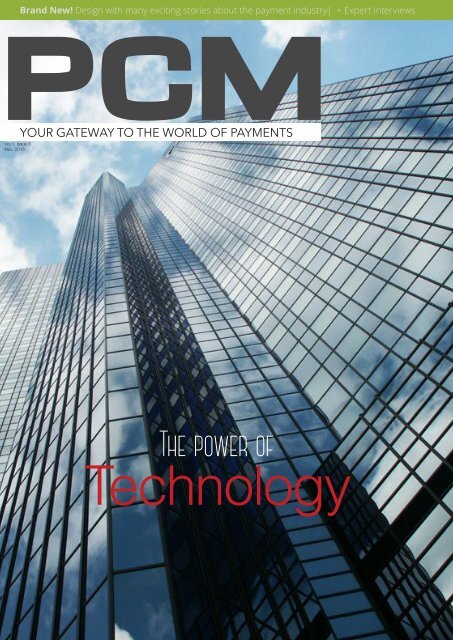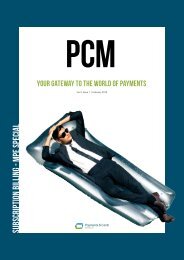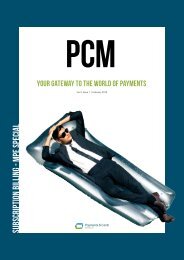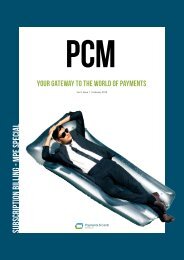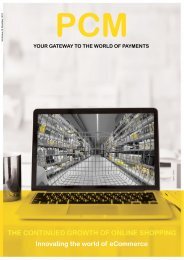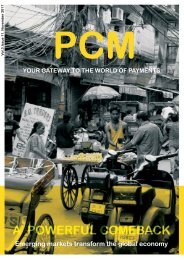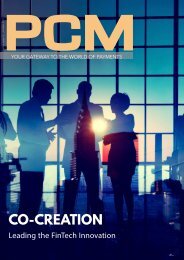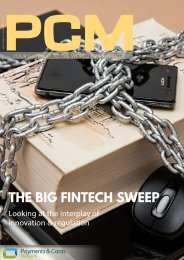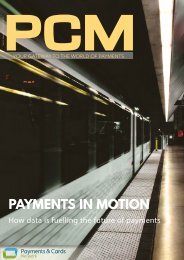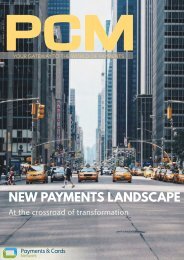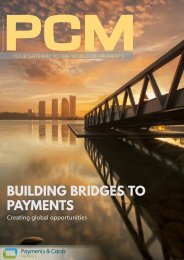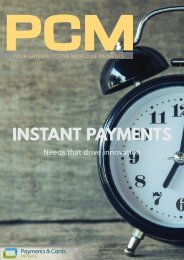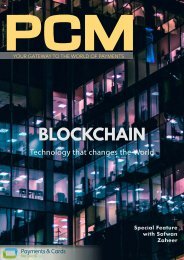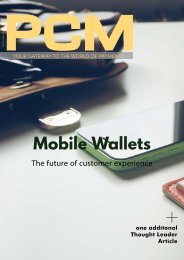PCM Vol.1 - Issue 6
You also want an ePaper? Increase the reach of your titles
YUMPU automatically turns print PDFs into web optimized ePapers that Google loves.
Brand New! Design with many exciting stories about the payment industry| + Expert Interviews<br />
<strong>PCM</strong><br />
Vol 1. <strong>Issue</strong> 6<br />
Nov. 2015<br />
YOUR GATEWAY TO THE WORLD OF PAYMENTS<br />
The power of<br />
Technology
Welcome to the 6th issue!<br />
You are reading the sixth issue of the Payments & Cards Magazine. In order to<br />
keep our clients, associates, subscribers and all payments professionals in the<br />
loop, we have decided to create a monthly magazine, now already in it’s sixth<br />
issue.<br />
The sixth issue features events in the payments industry, thought leaders articles,<br />
top jobs and much more! The magazine is currently expanding its scope and will<br />
cover topics such as, Q&A, product/ service reviews, statistics & facts, educational<br />
articles and other great content in the following editions!<br />
The magazine is also a good way for you to keep in touch with what is happening<br />
in the Payments world as well as like minded professionals. If you haven’t checked<br />
in with us lately, we think you will be surprised and excited about all the wonderful<br />
things happening in the industry.We hope to hear from you soon, and we welcome<br />
your feedback!<br />
Throughout each issue, there will be descriptions and lists of events within the<br />
payments industry happening this month, as well as announcements and latest<br />
developments and partnerships. If you are a thought leader and would like to be<br />
featured or present your thoughts, please get in touch.<br />
On the other hand, as a business, the magazine offers you various advertising<br />
possibilities. Want to learn more? Just contact us!<br />
If you have any questions, suggestions, or concerns, please address them to the<br />
editors:<br />
Amir Abdin - amir@paymentsandcardsnetwork.com<br />
Duc Dang - duc@paymentsandcardsnetwork.com<br />
The Payments & Cards Network team wishes you good reading!<br />
002
Contents<br />
thoughtleaders<br />
spotlight<br />
11<br />
3<br />
6 9 14<br />
STORIES<br />
3<br />
6<br />
8<br />
9<br />
Thought Leaders: Mobile Payments in Sub-Sahara<br />
Jide Akindele continues the series about the development of the<br />
mobile payments industry in a promising part of Africa.<br />
Thought Leaders: the online payment market<br />
Peter Lyster talks about the latest development in the online<br />
payment market and gives an insight into PayPal’s new strategy.<br />
Thought Leaders: Fintech vs. Banking<br />
Son Nguyen discusses the emerging importance of Fintech<br />
companies in the payment industry.<br />
Expert Interview: Welcome to the world of PAPISPs<br />
Francesc Altisent shines a light on the new Payment Service<br />
Directive 2 (PSD2) and its impact on the payments sector.<br />
12<br />
14<br />
15<br />
Spotlight: Sign2Pay<br />
We signed up and talked to one of the most<br />
pomising and innovative start-up companies.<br />
Hot Jobs<br />
Looking for a new role and exciting challenges?<br />
Check out our latest job opportunities!<br />
Events<br />
Here we showcase the most exciting upcoming<br />
events in the payment industry.<br />
003
By Jide Akindele<br />
November 2, 2015<br />
Thought Leaders Corner<br />
global<br />
business<br />
This is the second edition of Jide Akindele’s series<br />
on the payment market in Sub-Sahara Africa<br />
© SES S.A<br />
Mobile Payments<br />
in Sub-Sahara Africa<br />
The Sub-Saharan mobile payment ecosystem is booming,<br />
with over 64 million mobile wallets (World Bank report).<br />
The majority of mobile payments are micro, used for<br />
local services, however, a revolution is occurring on the<br />
international scene.<br />
Mobile payments for services such as digital content are now<br />
being adopted on some international websites as a payment<br />
option geared towards Sub-Sahara consumers, who now<br />
use mobile wallets instead of card payments. Thanks to<br />
innovative and collaborative work of a few forward thinking<br />
companies, such as BBM, SmartVOD, Talk360, WhoTrades<br />
and others coming on board.<br />
More international players like Apple, Google, Amazon,<br />
Facebook, need to adopt the mobile wallet payment option in<br />
004
MMIT, Mobile Media Info Tech, is a mobile payment processor with a mission to<br />
revolutionize the mobile payment process.<br />
MMIT focuses on the Sub-Sahara Africa market and partners with financial institutions<br />
and international merchants to provide value added services to mobile wallet providers<br />
and users. Please visit MMIT at www.mmitonline.com.<br />
Jide Akindele, Founder,<br />
MMIT<br />
Jide is a visionary entrepreneur with a deep and wide<br />
knowledge of technologies based in the mobile money and<br />
payment transaction space. Mr. Akindele has held various<br />
directorship positions for companies in West Africa and has<br />
worked in USA, Nigeria and the UK since 2007.<br />
Sub-Sahara Africa in order to tap into the huge<br />
1 billion plus consumer base.<br />
A typical day in the African mobile wallet<br />
payment space; location: Nigeria; bought<br />
airtime, bought bandwidth, paid bills, bought<br />
VOIP for long distant calls, bought stickers on<br />
an app store, subscribed to international Video<br />
on Demand content; I am an average African<br />
consumer, within the highest demographic, now<br />
that’s amazing, and this is not fiction! Bring me<br />
more content, a typical cry of millions of young<br />
savvy African content hungry consumers across<br />
the continent.<br />
In contrast, tried to buy an APP with a card,<br />
DENIED! Tried to buy an educational e-book,<br />
DENIED! Tried to buy an e-Gift card, DENIED!<br />
Tried to buy gaming tokens DENIED! “This service<br />
is not available in your region” (Miserable day).<br />
This is a very typical experience across Sub-<br />
Sahara Africa. This however, begs the question,<br />
why are Facebook, Apple, Amazon and Google<br />
not operating in this space? These brands have<br />
huge amounts of followers in the Sub-Sahara<br />
region, however, consumers are let down by<br />
the lack of enablement on the m-commerce<br />
front and payment option capabilities. This very<br />
surprising when Sub-Sahara Africa still accounts<br />
for the majority of live mobile payment services<br />
globally, estimated at (53%) according to a<br />
GMSA report.<br />
Sub-Sahara Africa mobile payments is no<br />
longer just a payment option for unbanked,<br />
but is emerging to a de-facto payment option<br />
for goods and services across borders. Most<br />
developed regions of the world use mobile<br />
wallet payments for convenience, Africa being a<br />
“mobile first” region uses it as a standard tool<br />
of choice. Therefore, rapid adoption of Mobile<br />
payments in Sub-Sahara markets will be the<br />
main driving force of m-commerce growth.<br />
Mobile payments will be a strategic business<br />
enabler for international brands wanting to<br />
expand into the Sub-Saharan markets.<br />
005
eCommerce<br />
commerce<br />
Africa<br />
Africa Confex<br />
17 & 18 FEBRUARY 2016 | THE CTICC, CAPE TOWN<br />
WWW.ECOMMERCE-AFRICA.COM<br />
Solutions<br />
PRE-CONFERENCE WORKSHOPS<br />
DISRUPT COMMERCE 2016 | 16 FEBRUARY<br />
DISRUPT<br />
COMMERCE<br />
CARDS, PAYMENTS, MOBILE MONEY<br />
creative innovation<br />
PROUDLY PRODUCED BY:<br />
Follow @eCommerceConfex and @KineticEventsSA on<br />
Twitter for daily updates and news feeds.
Is the online payment market growing as expected?<br />
© picjumbo<br />
Trends online payment market<br />
Peter Lyster, Marketing Manager at Nochex, speaks about the latest deveopments in the online payment market<br />
For anyone looking to be employed<br />
within the payments industry a<br />
recent article that appeared on<br />
the Internet Retailing website,<br />
might have made them think that the<br />
online payments market was grinding<br />
to a halt. The headline read “Online<br />
and offline sales slump as consumers<br />
less willing to spend”, but the article<br />
went onto talk about how online sales<br />
had only slowed down; the market<br />
was still growing at an eye-wateringly<br />
impressive 11.5% per annum.<br />
Now 11.5% is down from those heady<br />
days when growth was measured in<br />
three-digits, but double digit growth<br />
is still something most businesses<br />
would give their eye-teeth for. And,<br />
while it is tempting to think that<br />
online payment is becoming the<br />
ugly sister to mobile payment’s<br />
Cinderella, the reality is very different.<br />
Of course, all the eye-catching stories<br />
are often about mobile payments and<br />
how the latest technology is being<br />
harnessed in some new way to exploit<br />
it. In fact, there is a great deal going-on<br />
with online payments as the market<br />
gears-up for what are certain to be<br />
Online sales<br />
continue to grow.<br />
challenging times ahead. In the US that<br />
bastion of online payments eBay has<br />
parted company with PayPal. Although<br />
they are still locked together for a fixed<br />
period to protect both their interests,<br />
PayPal has had to make adjustments<br />
since it is now a publicly quoted<br />
company in its own right and has to bow<br />
to its investors, with no protection from<br />
its previously doting parent company.<br />
© pixabay<br />
007
Paypal<br />
under<br />
pressure<br />
© pressmaster - Fotolia.com<br />
#57550673<br />
PayPal recently announced a 30%+ increase<br />
in charges for internet merchants that have<br />
less than $1.2 million turnover per annum.<br />
Such an announcement has not gone<br />
unnoticed in the UK and many online businesses<br />
are now apprehensive about their future, should<br />
PayPal apply the same increase here. Such a<br />
big rise signals a very different attitude going<br />
forward, and will be a cause of considerable<br />
disappointment to those many online sellers<br />
who have remained loyal supporters of PayPal<br />
over the years. PayPal knows it must continue to<br />
compete in its traditional markets, while at the<br />
same time satisfying its new investors. However,<br />
industry observers observe that there is a view<br />
within PayPal that believes it has reached a point<br />
where merchants who use PayPal have little<br />
choice but to continue using it – even when it<br />
raises its charges so dramatically. But PayPal<br />
has no room for complacency. The market has<br />
seen a plethora of new entrants and all of them<br />
really must have a substantial share of the pie<br />
to placate their backers. In the past month<br />
there have been major announcements by<br />
Amazon, Facebook and Twitter, amongst others,<br />
indicating that they will not let PayPal play<br />
the game entirely in its own way. Meanwhile,<br />
the global card schemes have shown their<br />
willingness to put their considerable money<br />
where their mouths are, launching their own<br />
electronic wallet solutions, and in Visa’s case,<br />
deciding to rebrand what was already a very<br />
new e-wallet product. This jostling for position<br />
has been driven by the huge rewards at stake<br />
to the winners. How this will work out and who<br />
will come out on top will take time to unfold, but<br />
there can be little doubt that there are to be<br />
major implications for anyone employed in or<br />
who is looking to be employed within the online<br />
payments industry.<br />
About Nochex<br />
Nochex is the UK’s leading independent online<br />
payments company, concentrating on several specialist<br />
areas that are challenging spaces for the large internet<br />
payments corporations to operate. It has recently<br />
become a leader in the provision of payment service<br />
solutions to networks operators, where multiple<br />
smaller organisations and individuals use the services<br />
of a master account holder to leverage competitive<br />
advantage. Such networks include websites catering for<br />
auctions, advertising, communities, education, markets,<br />
sports, clubs, and entertainments.<br />
Peter Lyster,<br />
CMO, Nochex<br />
With more years’ experience in marketing financial and<br />
frontier technology companies than he cares to admit,<br />
Peter is the CMO of Nochex, he is a member of the<br />
Chartered Institute of Marketing, and happily provides<br />
straightforward guidance to many online ecommerce<br />
businesses ranging from mid-tier internet retailers<br />
through to one-person operated websites.<br />
008
Fintech vs. Banking<br />
By Son Nguyen<br />
November 2, 2015<br />
© picjumbo<br />
Fintech is the future of the bank industry, not their nemesis. In the financial industry, a new type of start-ups have spawned and<br />
Rampaged in a once stronlgy protected and highly regulated market. We know them as Fintech.<br />
These players have initiated new markets or revamping old<br />
aging business. Their targets usually focus on business where<br />
banks have a high margin and where traditional institutions<br />
can’t keep with the need and innovation coming from the<br />
digital space. In a defensive posture, many banks are trying<br />
to protect their assets and somehow become reluctant to<br />
interact with these new actors. However, Fintech did and<br />
will bring agility and innovation where there were limited<br />
successes in these traditional sectors. The paragon would<br />
be that a new breed of financial services create and provide<br />
consumers real innovation and create a bridge between<br />
traditional bank and financial services and those new digital<br />
services.<br />
From a higher overview, the outcome might be different.<br />
If we look back, 15 years ago another sector did face the<br />
same issue, i.e. the Retail. 15 years later, 8 out of 10 largest<br />
e-commerce players are owned by Retail. Even during these<br />
years, some believed that e-commerce would kill the retail<br />
now history has proven it probably will not be the case.<br />
Digital, entrepreneurship and investments allow the sector to<br />
grow faster and mutate to the next generation of consumers<br />
services. Afterwards, since the traditional actors would be<br />
able to acquire the Fintech, it will only benefit them and in<br />
competitive way in comparison to if they’ve tried to innovate<br />
themselves.<br />
Of course, amidst the pack a few players will become the<br />
“Amazon” of the Fintechs but the rest of the industry will<br />
probably still be (or be owned) by the same names we<br />
already know. So Fintech might be more of an evolution of<br />
the Financial Industry rather than a Spin-Off. This is of course<br />
a very personal take, but let’s rendezvous in 15 years to see<br />
Son Nguyen<br />
Program Director at<br />
Vente-privee<br />
Son Nguyen oversees strategic plans<br />
for Finance and in particular Payment<br />
and Fraud. He’s part the MRC European<br />
Advisory Board and of the FEVAD for<br />
payment commission and along with<br />
other regulatory commissions with<br />
French authorities.<br />
009
Experts Interviews<br />
Welcome to the<br />
world of PAPISPs<br />
The Payments & Cards Network dived deep into<br />
PSD2, what it entails and what it means for the<br />
payments industry. We sat down with Francesc<br />
Altisent, payments expert with a great deal of<br />
knowledge on PSD gathered by years of professional<br />
working experience in the industry. We discussed<br />
various points of attention regarding the Directive<br />
and here is what he has to tell us.<br />
010<br />
Francesc Altisent<br />
Payment Advisor and<br />
Solution Expert, SlimPay<br />
When the Payment Services<br />
Directive (PSD2) replaces the<br />
existing PSD it will have a wider<br />
scope than only harmonising European<br />
Economic Area payments to ensure<br />
consistency of processing between<br />
countries. It also seeks to open the<br />
marketplace and thus cover the many<br />
new innovative payments services.<br />
What is PSD2?<br />
The PSD2 is the second Payment Service<br />
Directive approved by the European<br />
Union that is expected to regulate<br />
and define the framework of activity<br />
of banks and financial institutions in<br />
the years to come. It is important to<br />
mention the letter D from Directive,<br />
which means that after the official<br />
approval was given by the European<br />
parliament at the beginning of October,<br />
every local parliament in the European<br />
Union has 24 months to transpose it<br />
to the local regulation. That is when<br />
the PSD2 will start to mean something<br />
very specific for PSPs, banks, other<br />
payment institutions and ultimately<br />
for Customers and Merchants.<br />
What is the main purpose of PSD2<br />
with regards to consumers and<br />
organisations?<br />
As for many other initiatives raised<br />
by the European Union, this directive<br />
is two fold (legal security of certain<br />
practices & foster free market as well<br />
as competition through the EU). On<br />
one hand, it is intended to provide<br />
legal security to certain payment<br />
initiatives and practices that have been<br />
generalised in the market in the last few<br />
years such as account aggregation by<br />
third parties or payment instructions on<br />
behalf (i.e. money in the supermarket)<br />
of the consumer (i.e. Sofort); it will<br />
protect both the service providers and<br />
the consumers using them. On the<br />
other hand, it will open up the European<br />
market and allow customers and<br />
merchants with a new (or so it would<br />
seem) set of competitive payment<br />
instruments that are challenging<br />
the already existing established<br />
payment methods like cards. Simply<br />
put, customers and merchants from<br />
anywhere in Europe will be able to enjoy<br />
a new host of competitive instruments<br />
originally created for other markets.<br />
What are the most relevant changes<br />
introduced by PSD2 and what is<br />
your personal opinion on these?<br />
As most of the analysts in payments<br />
I consider that the most relevant is<br />
the creation of two very well defined<br />
entities and the roles that these<br />
can perform. The AISP (Account<br />
Information Service Provider ) and PISP<br />
(Payment Initiation Service Provider), by<br />
themselves have the power to capsize<br />
the current payment ecosystem. AISP<br />
will be allowed to provide aggregated<br />
Account information to the Customer<br />
that has been collected from one or<br />
more Payment Institutions. The PISP<br />
will be allowed to instruct payments on<br />
behalf of the Consumer through their<br />
bank account. All this will be possible<br />
through a mandated subset of APIs<br />
that the account holder institutions<br />
(mostly banks) will be required to<br />
define and standardise according<br />
to what the EBA will define in a year
and a half from now. The best part<br />
is that the Consumer will be allowed<br />
to provide recurring authorisation<br />
to receive these services over time.<br />
Would you consider it more of a<br />
threat or an opportunity?<br />
In my opinion, it really depends on how<br />
you look at it. Looking at compliance<br />
projects (PSD2 is one of them) as<br />
something that you are forced to do, is<br />
not the right way of viewing compliance.<br />
My approach to compliance is<br />
“compliance++”, in the sense that<br />
financial institutions are mandated<br />
to create/control/modify/etc., but<br />
they should not stay there if they are<br />
willing to lead in the post-compliance<br />
scenario. What the regulator does not<br />
say, and this is where advisors play<br />
an important role, is how the same<br />
regulation or directive can be pushed<br />
to its limits to provide new business<br />
cases and new revenue streams for<br />
financial institutions and also banks.<br />
A specific example in relation to<br />
what we discussed in the previous<br />
question, PSD2 defines the mandatory<br />
existence of a subset of APIs for the<br />
banks to offer account information and<br />
payment initiation. Why banks would<br />
not think also about offering APIs to<br />
provide identification services (based<br />
on the KYC they already collected for<br />
years)? As side note, while payment<br />
transaction costs are in the cents or<br />
tenths of cents, identity transactions<br />
are in the euros or tens of euros.<br />
Do you think PSD2 should be<br />
discussed more in the payments<br />
community as we do not hear much<br />
about it, even though its going to be<br />
put into effect soon?<br />
I think that slowly the payment<br />
community is getting more and more<br />
aware of the existence of PSD2. Maybe<br />
because now it is a reality. And well, a<br />
lot of people still think that PSD2 will<br />
be like SEPA, something that was done<br />
last minute. However, I think that the<br />
first in the class are already starting<br />
to take positions for the race and<br />
start to propose how the status quo<br />
can be leveraged before the deadline<br />
approaches. I have been in discussions<br />
with various large European players and<br />
most of them are already taking specific<br />
actions towards taking advantage of<br />
the new PSD2 regulations. Let’s keep<br />
in mind one thought, the early thought<br />
leaders of today are going to be the ones<br />
with a bigger advantage tomorrow.<br />
PSD2 is trending to follow technical<br />
innovation, what will the biggest<br />
impact be on payment companies<br />
and how will it affect them in<br />
general?<br />
PSD1 was followed by the apparition<br />
of plenty of alternative payment<br />
methods and PSPs, due to the clearly<br />
defined framework that followed<br />
that directive. I think that PSD2 will<br />
bring to the payments market the API<br />
hubs. Why this and not something<br />
else? Everything comes from tight to<br />
impossible deadlines defined to all<br />
parties by these directives (18 months<br />
to define the standard by the EBA and<br />
6 additional months for the going live)<br />
and the uncertainty surrounding them.<br />
Dynamic organisations are needed<br />
to provide a steady interface with the<br />
existing banking players that can be<br />
adapted once the regulation appears<br />
and requires to do things a certain way.<br />
Welcome to the world of the PAPISPs<br />
(Payment API Service Providers).<br />
If you were asked to give advice to<br />
payment companies to best prepare<br />
for it, what would you tell them?<br />
PSD2 represents an unprecedented<br />
ocean of opportunities for new<br />
entrants in the payment ecosystem.<br />
Creative thinking will allow existing<br />
payment institutions to diversify their<br />
business and prepare for the future in<br />
a steady way. Compliance ++ is the way<br />
to go, anything else is exposing oneself<br />
to loss of business in the years to come.<br />
What does this mean for banks?<br />
Will they take a piece of the cake or<br />
will it just be another blow out for<br />
them?<br />
If they will or if they won’t is up to them.<br />
I think that they should, otherwise they<br />
risk losing a large part of revenue. And<br />
honestly, PSD2 has been approved only<br />
a few months later than the MIF and in<br />
conjunction with the instant payment<br />
debate. I think that there are too many<br />
risks in these three topics for not taking<br />
them into account, evaluating them and<br />
providing an aggressive business plan<br />
to leverage what they can bring to the<br />
banking ecosystem.<br />
As a professional in the payment<br />
industry, do you think it is necessary<br />
or not to have such directive in<br />
effect?<br />
Customers and merchants are still<br />
suffering today from the banking<br />
practices that started 50 years ago.<br />
The European Union has created this<br />
directive to open the market to new<br />
players, I think that the application of<br />
this directive will only bring good things<br />
to the final stakeholders eg. customers<br />
and merchants. It may come with some<br />
suffering from the banks, but they now<br />
have the choice to suffer or to leverage. It<br />
is ultimately up to them what they prefer.<br />
“...the early thought<br />
leaders of today<br />
are going to be<br />
the ones with”<br />
bigger advantage<br />
tomorrow.”<br />
011
Spotlight<br />
In this brand new section in the <strong>PCM</strong> we’ll take a close<br />
look at some of the most innovative and promising<br />
startup companies in the payment industry.<br />
Using Your
Caption from left to right: Nicolas Mertens, Tom<br />
Schouteden and Nick Lloyd. Sign2Pay was founded<br />
in November 2013 by Nicolas. Joining him were<br />
co-founders Nick Lloyd and Tom Schouteden, and<br />
Joost Baaij, VP Engineering.<br />
The FinTech sector expands<br />
continuously and therefore<br />
becomes more and more<br />
competitive. Many start-ups are<br />
looking to innovate and differentiate<br />
themselves in every aspect of the<br />
industry. One battle ground is the<br />
payment authentication process.<br />
We speak to Nicolas Mertens, CEO<br />
and founder at Sign2Pay, about<br />
the company’s development in the<br />
market and their next big steps.<br />
Where did the idea for Sign2Pay<br />
come from?<br />
Sign2Pay is a company providing a<br />
secure and convenient mobile payment<br />
method that allows consumers to<br />
use their touchscreen device to pay<br />
with their bank account number<br />
and personal signature. In late 2013,<br />
observations indicated that the mobile<br />
traffic was increasing but there were<br />
no transactions. Next to that our<br />
generation is more impulsive and wants<br />
to manage things “on-the-go”. That’s<br />
where the idea originated. We wanted<br />
to cope with the predominant impulsive<br />
purchasing behavior our generation<br />
is so fond of but at the same time it<br />
needed to be easy to use and secure.<br />
How does your payments method<br />
differ from others?<br />
Our payment method is based on<br />
our consumers’ unique signatures.<br />
We utilize real-time signatures input<br />
as they provide the possibility to be<br />
used on any touch-enabled mobile<br />
device, anywhere, at any time. Due to<br />
the complexity of Sign2Pay’s biometric<br />
authentication in the form of a signature<br />
it ensures its users a maximum level<br />
of security and in fact it is even safer<br />
than fingerprint or facial recognition.<br />
What we do is using customers<br />
signature to track their gestures<br />
and the signature as a whole is a<br />
long password. To be more specific,<br />
Sign2Pay’s payment method measures<br />
1200 parameters, which combine<br />
for a unique reference set in order to<br />
guarantee the safety of the password.<br />
So, our company strives to bring<br />
mobile payment security to the<br />
next level while making it very<br />
user friendly at the same time.<br />
What is more, our payment method<br />
allows users to pay with their debit<br />
card, which is mostly preferred by<br />
Europeans to pay with. By removing<br />
usual obstacles such as card readers,<br />
redirects and external apps, we<br />
also always stay within the trusted<br />
web environment of the merchant.<br />
Based on that Sign2Pay can provide<br />
merchants with higher conversion<br />
rates. Ultimately, we want to make<br />
both consumers and merchants happy.<br />
Do you think Sign2Pay can compete<br />
with other popular payment service<br />
like Apple Pay?<br />
Well, we don’t see Apple Pay as a<br />
competitor because we are a close<br />
loop payment method. That means<br />
that we find and acquire the merchants<br />
and transactions from merchants but<br />
we also allow the consumer to set up<br />
an account with us connected to their<br />
local bank. So we play both games.<br />
What Apple Pay and Android Pay<br />
do is more being an authentication<br />
mechanism, which signals that it’s this<br />
specific phone, which wants to start a<br />
transaction. You still need an acquiring<br />
partner behind it for a merchant and as<br />
a consumer you need to upload your<br />
bank card details, which means a point<br />
of issuing that card also needs to be<br />
in place already. In the end, payment<br />
services like Apple Pay function more<br />
as a facilitator. However, what we would<br />
like to do when Apple Pay arrives at<br />
the European shore is to collaborate<br />
with them in terms of integrating our<br />
Sign2Pay accounts with the Apple<br />
Pay mechanism if they are interested.<br />
Would you also consider to add<br />
other technical functionalities to<br />
your provided payment service?<br />
That depends on how the market<br />
evolves. Right now we are very focused<br />
on pursuing signature recognition<br />
advancement as the signature<br />
verification also holds a lot more use<br />
options. For example, think of people<br />
in the U.S where consumers give their<br />
credit card to their kids or other parties<br />
and one bank card could hold many<br />
signatures. These are many possibilities<br />
which are yet to be explored and<br />
developed. We are always eager to<br />
013
learn about new technologies to see<br />
what fits best for out clients, though.<br />
Are there significant milestones<br />
Sign2Pay has already achieved?<br />
One of the most significant milestones<br />
within Sign2Pay is the maturing of the<br />
technology we are able to utilize. We<br />
have a great team of data scientists<br />
and developers who are constantly<br />
improving the algorithms to provide<br />
the very best user experience for<br />
our consumers. Next to that the<br />
onboarding of the very first client was<br />
very important to us as is the setup<br />
of our sales team, which is almost<br />
approaching its six-month anniversary.<br />
It’s a slow but fruitful process while<br />
getting acquainted with how to manage<br />
sales to our targeted customers. We also<br />
see our efforts and growing potential<br />
approved since our initial investors<br />
are double-down for this project.<br />
What is your outlook for the near<br />
future?<br />
Our goal is to become the market<br />
leader worldwide in digital signatures<br />
by 2018. The reason why we think<br />
we can become a big global player is<br />
that nowadays nobody authenticates<br />
digital signatures excluding certificate<br />
signatures. Other companies working<br />
with digital signatures mostly use blank<br />
canvas where you draw something on,<br />
then it’s captured, stored and there<br />
it ends. Whereas, we actually look<br />
at the data on that canvas and do a<br />
verification on the signature. And as<br />
far as we can tell, Sign2Pay is the only<br />
commercial company applying that<br />
process and our technology is also the<br />
most advanced in authenticating what<br />
you write down on that blank canvas.<br />
Are there other exciting projects<br />
Sign2Pay is currently working on?<br />
Yes, I actually have some fairly<br />
exciting happening coming up. When<br />
looking at micro-payments, which are<br />
e-commerce transactions involving a<br />
very small sum of money in exchange<br />
for something made available online.<br />
Just imagine for example you would do<br />
a text payment to a gateway in Belgium<br />
or the Netherlands. Then you would<br />
have to pay about 50% to KPN or the<br />
mobile gateway. That means there is a<br />
lot of money involved. We are working<br />
on that extensive cost structure and<br />
came up with a plan, which for now only<br />
focuses on non-profit organizations.<br />
In November 2015 we want to offer<br />
a micro-payments service for them<br />
so that any transaction below 3 Euro<br />
will be free of charge. This will allow<br />
to process and receive 100% of the<br />
micro-payment transaction. However,<br />
the carrier costs will influence those<br />
transactions as well. Who knows yet,<br />
but Sign2Pay will keep developing<br />
that algorithm to possibly offer that<br />
service to other parties as well.<br />
“A fast and secure mobile checkout: only rotate your<br />
device, sign on the screen - and that’s it!”<br />
014
Hot Jobs<br />
b<br />
Head of payment<br />
Berlin<br />
b<br />
Sales Executive<br />
Johannesburg, South Africa<br />
b<br />
Head of International Sales<br />
Amsterdam<br />
b<br />
Payment Expert<br />
Germany<br />
b<br />
Sales Manager<br />
Benelux & CE<br />
b<br />
Sales Manager<br />
APAC<br />
b<br />
Managing Director<br />
Europe<br />
b<br />
Payments Product Manager<br />
London<br />
b<br />
Marketing Communication &<br />
Branding Manager<br />
Singapore<br />
b<br />
Software Process Engineer<br />
Amsterdam<br />
b<br />
Regional Managing Director<br />
Manila, Philippines<br />
b<br />
Vice President Operations<br />
Paris<br />
015
Events<br />
Date: March 6-8, 2016 | USA<br />
This executive three day event<br />
is full of relevant topics such as<br />
building customer trust around<br />
mobile security, converting mobile<br />
traffic into sales by implementing a<br />
seamless mobile payment process<br />
and more! This event is designed for<br />
senior-level executives responsible<br />
for the mobile payment strategy<br />
within their organisations.<br />
Date: Nov 25th, 2015 | London, UK<br />
This is a one day conference for<br />
the payments industry to explore<br />
the latest innovations in emerging<br />
payments. Heroes in payments<br />
will share their stories of how they<br />
successfully launched new and<br />
innovative payment products.<br />
Following that, an innovative<br />
showcase featuring their new<br />
trailblazers of the payments<br />
industry.<br />
016<br />
Date: Nov 10-11, 2015 | Berlin<br />
ISSE is Europe’s leading<br />
independent, interdisciplinary,<br />
security conference. The event<br />
is designed to educate & inform<br />
on the latest developments in<br />
technology, solutions, market<br />
trends and best practices. It is a<br />
two day, four track programme<br />
which provides rich, educational<br />
content for both government and<br />
commercial end-users.<br />
Date: Nov 12-13, 2015 | Sao Paulo<br />
This two day event in Sao<br />
Paolo focuses on strategic<br />
partnerships that allow you to<br />
scale your payments channel,<br />
discovering market trends &<br />
growth opportunities in the<br />
Americas’ cards & payments<br />
networks and more! Card security,<br />
interoperability, and financial<br />
inclusion in the age of payments<br />
system automation and finality of<br />
real-time settlements.
Events<br />
Date: Nov 17-19, 2015 | Paris<br />
Now in it’s 30th anniversary,<br />
Cartes is the leading event in the<br />
global market of secure payment<br />
solutions, identification &<br />
mobility, serving users, matching<br />
their current ways of living<br />
and proposing new and more<br />
convenient solutions. Gathering<br />
attendees from the Financial,<br />
Retail, Government, Identity &<br />
Access, Telecommunications and<br />
Transportations sectors.<br />
Date: Nov 24-25, 2015 | Zurich<br />
This is an annual platform<br />
addressing the topic of payment<br />
transactions in Switzerland. It is<br />
the meeting point for all those who<br />
are interested in payment trends.<br />
This two day conference offers<br />
insight into mobile payments,<br />
mobile commerce, mobile banking<br />
and innovative payment models.<br />
Date: Nov 18-19, 2015 | Instanbul<br />
Date: Nov 10-11, 2015 | Amsterdam<br />
An executive conference focused<br />
on the connected home ecosystem<br />
& the Internet of Things. It is a two<br />
day summit which examines the<br />
impact of connected devices and<br />
services, including entertainment,<br />
controls, digital media, security<br />
and cloud services. Offering insight<br />
into new and innovative business<br />
strategies and partnerships,<br />
current & future technologies and<br />
much more!<br />
This is a special event paving<br />
the future of digital economy,<br />
welcoming thousands of C-level<br />
global leaders, digital & tech<br />
entrepreneurs and founders<br />
from 110 countries. The event<br />
focuses on Media, Advertising,<br />
Digital Entertainment, Internet<br />
of Things. BigData, Cloud, Money<br />
and Payments. Bridging the world<br />
of enterprise and startup for<br />
innovative collaboration.<br />
017
You think you are a good match or know<br />
someone who is?<br />
Apply Now!
Payments and<br />
Cards Network<br />
Driving Innovation through Innovation<br />
You<br />
have any suggestions or ideas for the<br />
next issue of our <strong>PCM</strong> eMagazine?<br />
Get in touch today and maybe you will<br />
be featured in the next edition:<br />
Amsterdam Office<br />
Herengracht 576<br />
1017 CJ<br />
Amsterdam<br />
The Netherlands<br />
Email: info@<br />
paymentsandcardsnetwork.com<br />
Tel: +31 20 3030 257<br />
Fax: +31 20 8208 295<br />
Follow us today and stay up-to-date<br />
with the latest happenings in the<br />
payment world!


